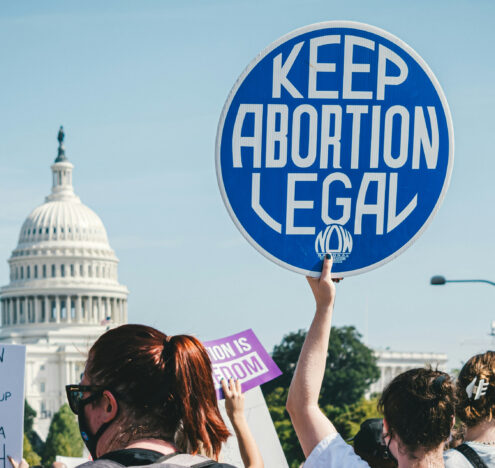In October 2023, the Congressional Commission on the Strategic Posture of the United States released its final report on “America’s Strategic Posture.” This congressionally mandated review of US nuclear strategy, policy and posture concluded that “America’s defense strategy and strategic posture must change in order to properly defend its vital interests and improve strategic stability with China and Russia.”
The commission thus came to the conclusion that the US needed to go beyond its current modernization plan to develop a capability “to deter and defeat both” Russia and China “simultaneously.” This includes modifying the US strategic force posture to address larger numbers of targets and changing the posture on so-called “theater” nuclear weapons to allow for the US to engage in two simultaneous nuclear conflicts in Europe and Asia. While not every recent official report has advocated an arms buildup, the prevailing wisdom in policy and commentary circles is acceptance of a “coming arms race.”
The prevalence of this acceptance of arms racing and nuclear war fighting talk does not simply reflect the world we are in, it has political power to influence that world, to provoke action and reaction. This language has consequences. A new buildup of nuclear weapons and talk of nuclear war fighting is obviously dangerous because we know there is no winner of a nuclear war, never mind two. But even if those weapons are never used, they have impacts on the places and peoples in which they are produced.
Waste
I have recently spent a month conducting research in New Mexico, a state that has borne many of the consequences of the development of US nuclear weapons. In New Mexico, uranium miners and downwinders who lived near the very first nuclear test are not only dealing with generations of cancers caused by the nuclear weapons complex and the Trinity Test but have also had to fight for years to be included in government compensation schemes, a battle that is still ongoing.
Such harms are not mentioned in the recent Strategic Posture Commission Report. The report encourages an expansion of “the US nuclear weapons defense industrial base and the DOE/NNSA nuclear security enterprise, including weapons science, design, and production infrastructure” and “the full range of NNSA’s recapitalization efforts, such as pit production and all operations related to critical materials.” As such, it takes a “comprehensive” approach to what it deems necessary for its strategic recommendations including infrastructure, supply chain and labor issues. At no point in its 160 pages, however, does the report mention the word waste.
This is not the first comprehensive report on nuclear weapons that ignores the fact that weapons production has consequences beyond the strategic. Nuclear waste has long been an afterthought in weapons production, subservient to the demands of geopolitics. The Cold War nuclear arms race in the United States created “some of the world’s most dangerous radioactive sites with large amounts of radioactive wastes, spent nuclear fuel (SNF), excess plutonium and uranium, thousands of contaminated facilities, and contaminated soil and groundwater,” according to the Department of Energy’s (DOE) Office of Environmental Management.
A new weapons buildup means more nuclear waste when the US government has not adequately funded the vast clean-up from the last arms buildup, not just in New Mexico but all over the country and beyond. The Department of Energy is responsible for the ongoing cleanup of 16 US sites and the management of 102 other legacy sites. DOE spending on these sites has remained relatively flat and will continue so according to proposed five-year appropriations for defense environmental cleanup, going from $7.07 billion for 2024 to $7.62 billion in 2028. This is despite the fact that cleanup consistently costs more and takes longer than planned and costs continue to rise sharply. The amounts of money spent are already staggering but still pale in comparison to what is needed. The GAO estimates for the site in Hanford, Washington alone are estimated to be up to $640 billion. This shows that waste is not a postscript to weapons production but an immense and expensive primary outcome.
A new nuclear weapons buildup also has serious consequences across multiple socioeconomic issues. To give just one example, Los Alamos National Laboratory (LANL) is already hiring 2,500 new workers to respond to the current call to produce 30 new plutonium pits per year. These workers come into an area in New Mexico where housing is already scarce and expensive, and infrastructure cannot support commuters. This then has devastating knock-on effects for those who live in nearby areas and do not benefit from the higher-than-local average LANL technical salaries. LANL expansion heightens the already stark economic inequalities of New Mexico where the median household income in Los Alamos County (one of the richest in the US) is more than twice that of neighboring Rio Arriba and Taos counties.
Poverty levels in Rio Arriba and Taos are also more than four times that of Los Alamos and twice that of the national average. Residents in these counties include those homesteaders whose land was taken for the Manhattan Project. Neuvo Mexicano/a and Pueblo communities near Los Alamos whose residents worked as maids, cleaners and laborers in Los Alamos during the Cold War now worry about the legacies of unsafe work and the pollution of their land and water from, for example, a chromium plume from contaminated water flushed into the Sandia Canyon (between 1956 and 1972) or a catastrophic spill of 1000 tons of uranium mill tailings in 1979 that was never properly cleaned. There are also safety concerns about ramping up production of new weapons plutonium pits at the two designated sites of Los Alamos and Savannah River Site in South Carolina.
Costs of Deterrence
It is therefore important to think about how a call for increasing nuclear weapons deterrence or war-fighting capacity even in the very best case scenario, if never used, has costs for those who already have experienced the sharp edge of the nuclear weapons complex, both in New Mexico and across the US and the world. Examining the complex and long-term health, environmental and socioeconomic impacts of weapons production in New Mexico makes visible what the Congressional Report avoids about the effects of “[e]xpanding the infrastructure and supply chain for the nation’s nuclear complex and its strategic capabilities.”
Perhaps the report’s authors could claim that these are the necessary consequences of the cost of national security, and negligible issues compared with the potential for nuclear war. Yet having clean water or an affordable place to live is not a negligible issue for anyone, and it is often the same communities, far from Washington DC, who are forced to repeatedly make such sacrifices. The issue that such policy reports always elide is what and whose security is deemed valuable and whose is dispensable.
Back in 1959, in the early days of the nuclear age, Bernard Brodie wrote that “a speculation about the probability of war is a speculation not about what the gods will do but about what men will do … it is important especially for the citizens of a great power like the United States to bear in mind, that within wide margins delimiting the choices available to us, what happens to us is largely affected by what we do.”
High-profile reports, such as “America’s Strategic Posture,” do not simply reflect the likelihood of an arms race — they contribute to it. As such, fatalism about nuclear buildup and potential nuclear war, as Brodie noted many years ago, neglects the fact that “great powers” do not simply react to the world as it is but make choices that shape it. New Mexicans have long had to live with the everyday consequences of such choices.
The fieldwork informing this commentary was funded by the International Campaign to Abolish Nuclear Weapons’ (ICAN) Critical Nuclear Weapons Projects, 2023-2024.





















